
With the smell of spring in the air, it’s hard to not want to rush to the first green market and buy up all the plants to pot or plant in your garden.
However, before you get too excited, make sure you know you won’t have to make a second trip – to your veterinarian – if your dog tries to taste test your new garden.
If you choose to have houseplants, keep them as far out of reach of pets as possible. Even a not-so-toxic plant can be troublesome if your pet has eaten a significant amount.
If you have a cat, some of the plants below are toxic to them as well, but there are also additional plants that affect them. Check out our article on plants that are toxic to cats.
We're here to help you avoid purchasing or growing plants that are toxic to your dog, but if you suspect that your dog has eaten a poisonous plant or if they're showing symptoms of toxicity, get them to a veterinarian, emergency hospital, or call an animal-specific poison control hotline ASAP.
Popular Household Plants That Are Poisonous to Dogs
Skip to Specific Plant Toxicity
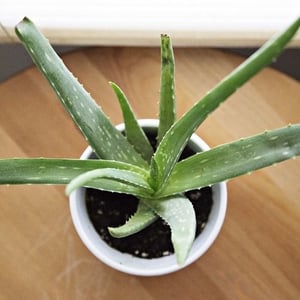
Aloe
Although aloe vera is known for its health benefits for us, it contains saponins (specifically anthraquinone glycosides), and this specific compound when ingested can be mild to moderately toxic to dogs. Anthraquinone glycosides act in a similar manner to laxatives in people.
Signs of Aloe Toxicity in Dogs
When eaten (particularly in large amounts), it may result in diarrhea as well as vomiting and abdominal discomfort.
Onset of Symptoms
Signs usually occur within a few hours of ingestion after the gastrointestinal system has had time to metabolize the toxin.
 Amaryllis
Amaryllis
Amaryllis plants are part of the Liliaceae family. Their toxin is an alkaloid (similar to the daffodil), and all parts of the Amaryllis plant contain this phenanthridine alkaloid.
The bulb is the most toxic part of the amaryllis plant, and although all parts of the plant are toxic, the bulb, which is often exposed in these plants, is the most dangerous part for dogs, as they contain needle-shaped raphide oxalate crystals, which are designed to specifically repel animals.
Signs of Amaryllis Toxicity in Dogs
If ingested, vomiting, decreased blood pressure, and shallow or difficulty breathing may occur.
If the bulb is eaten, its crystals will cause oral pain, irritation, and discomfort, resulting in excessive drooling, pawing at the mouth and face, occasional vomiting, and even occasional difficulty breathing.
Onset of Symptoms
Signs typically develop immediately if a dog bites or chews on the bulb causing oral irritation, the remaining symptoms may take up to 2–4 hours after ingestion.
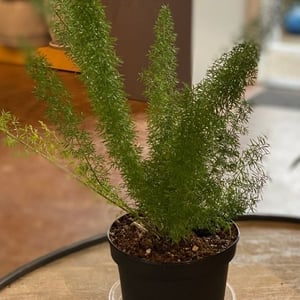
Asparagus Fern
Asparagus fern due to its fine foliage is commonly found in floral arrangements and often as houseplants. And although their toxicity is relatively mild, it is repeated exposure to the skin that may result in allergic dermatitis.
Additionally, ingestion of the berries can cause mild gastrointestinal upset such as vomiting, diarrhea, decreased appetite, and/or abdominal discomfort.
Signs of Asparagus Fern Toxicity in Dogs
Skin irritation and rashes from frequent physical contact. Eating the berries can cause vomiting, abdominal pain, tenderness, or diarrhea.
Onset of Symptoms
It may take several weeks to months of repeated dermal exposure for issues to arise with a dog’s skin, such as redness, irritation, hair loss, itching, etc. However, if the berries are ingested, gastrointestinal signs typically occur within hours.
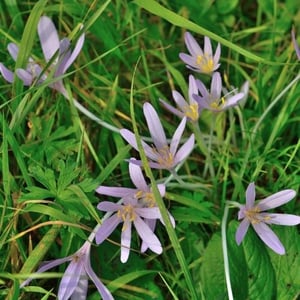
Autumn Crocus
There are two types of Crocus plants, and both are toxic to pets. One blooms in the spring (Crocus species) and one in the autumn (Colchicum autumnale).
The Crocus species (spring bloom) are more common and are part of the Iridaceae family. Ingestion of the spring bloom Crocus plants typically causes general gastrointestinal upset such as vomiting, diarrhea, and decreased appetite.
However, it is very important to not confuse the two species of Crocus species, as the Autumn Crocus, which is part of the Liliaceae family, contains colchicine which is known as a medication to treat gout or familial Mediterranean fever in people. It is very easy to overdose on Colchicine, making the Autumn Crocus especially toxic to pets.
Signs of Autumn Crocus Toxicity in Dogs
Eating the Autumn Crocus may cause severe vomiting, gastrointestinal bleeding, weakness, shock, liver and kidney failure, and even respiratory failure.
Onset of Symptoms
ALL parts of the plant are considered toxic, and symptoms can be seen within hours of ingestion.

Azalea and Rhododendron
Azaleas and Rhododendrons are part of the same plant species. Their toxic compound is Grayantoxin, which affects the sodium channels of the body which in turn affects the skeletal muscles (muscles that attach to bone) as well as the heart muscle.
ALL parts of these plants are highly toxic. It only takes an extremely small amount to be ingested to result in toxicity – only 0.2% of a dog’s body weight to cause serious issues.
Signs of Azalea and Rhododendron Toxicity in Dogs
Symptoms include excessive drooling, weakness, vomiting, diarrhea, decreased appetite, lethargy, abnormal heart rate or rhythm (arrhythmia), tremors or seizures, coma, and even death.
Onset of Symptoms
Typically seen within 4 hours of ingestion, depending on the amount eaten. Symptoms are largely gastrointestinal related, such as vomiting, diarrhea, drooling, lethargy, etc. So don’t be fooled by a simple upset stomach.

Ceriman
The Ceriman is one of the most popular household plants because of its tropical appearance. Commonly referred to as the Swiss Cheese plant because of the swiss-cheese-like appearance of its leaves. However, it may also be known as the Hurricane Plant, Mexican breadfruit, or Cut-leaf Plant.
Microscopic insoluble calcium oxalates reside on the leaves, which is what makes this plant toxic.
Signs of Ceriman Toxicity in Dogs
If chewed on, intense irritation to the mouth may result in swelling of the tongue, lips, and face. Symptoms may include excessive drooling, pawing at the face and mouth, whimpering or crying in discomfort, and occasional vomiting.
Additionally, difficulty swallowing may be seen on occasion as a result of swelling of the throat, as well as irritation to the skin if it comes in contact with any sap.
Onset of Symptoms
Signs typically develop immediately if a dog chews or bites on this plant, which will cause oral irritation. Gastrointestinal signs may take up to 2–4 hours post-ingestion.

Cyclamen (Persian Violet, Sowbread)
The cyclamen plant is a popular flowering plant, especially during the winter months. However, all parts of these plants contain triterpene glycoside saponins, which is what causes these popular plants to be toxic to dogs –with the highest concentration in the tuber (also known as the roots).
Signs of Cyclamen Toxicity in Dogs
Vomiting, diarrhea, and drooling will result if any part of the plant is ingested. However, if the tubers are ingested or any part of the plant is ingested in large amounts, cardiac problems, such as irregular heartbeat (arrhythmias), seizures, and death can occur.
Onset of Symptoms
Symptoms may occur immediately if the tubers are ingested, or if a large amount of this plant is ingested. However, symptoms may take several hours after ingestion if other parts, other than the tubers are eaten or a smaller amount was ingested.

Daffodils (Paper Whites, Narcissus, Jonquil)
Daffodils contain lycorine, an alkaloid toxin with properties that easily trigger vomiting when ingested. Similar to other plants mentioned on this list, in the outer layer of the bulb, there are crystals that cause severe irritation to the tissues of the mouth and result in drooling.
Signs of Daffodil Toxicity in Dogs
Ingestion of the bulb, plant, or flower can cause severe vomiting, diarrhea, abdominal pain, and even possible cardiac arrhythmias and/or slow, ineffective breathing or "respiratory depression."
Ingestion of large amounts of daffodils, particularly the bulb, which is the most toxic part, may result in convulsions, low blood pressure, tremors and/or heart rate and rhythm abnormalities (arrhythmias).
Onset of Symptoms
If a dog comes into contact with the crystal-covered bulb, symptoms typically develop immediately. However, the more severe symptoms can happen within 2–4 hours of ingestion and up to 8 hours post-ingestion.
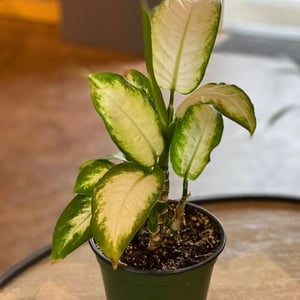
Dieffenbachia (Dumb Cane)
A popular house or office plant, dieffenbachia contain insoluble calcium oxalate crystals, like the Swiss Cheese plant, and if the plant is ingested or chewed on, these crystals will cause intense oral irritation and burning of the lips and tongue, and gastrointestinal tract irritation if swallowed.
Signs of Dieffenbachia Toxicity in Dogs
Extreme mouth irritation can lead to swelling of the tongue, lips, and face, including ulcers and blisters in the mouth.
Excessive drooling, nausea, pawing at the face and mouth, as well as vomiting, and even difficulty swallowing in some cases.
Rarely, swelling of the upper airway may occur as a result of the inflammation causing respiratory distress.
Onset of Symptoms
Signs develop immediately if a dog chews or bites on this plant. However, gastrointestinal signs may take up to 2–4 hours post-ingestion.
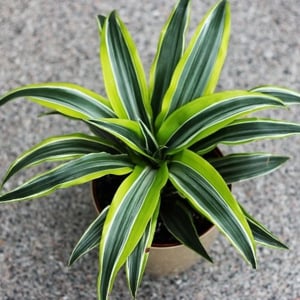
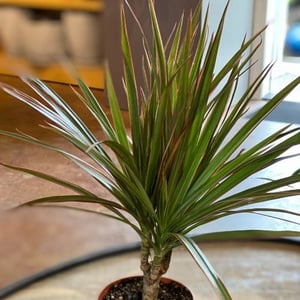
Dracaena (Corn Plant)
Also known as the cornstalk plant, dragon tree, or ribbon plant, the Dracaena is another common houseplant also containing saponins as their toxic chemical (similar to Aloe and other plants discussed above). It is toxic if ingested by your dog
Because this plant comes in many varieties, we've provided two versions in the photos.
Signs of Dracaena Toxicity in Dogs
Excessive drooling, mental dullness, change in energy level, lack of appetite, dilated pupils, and vomiting (occasionally with blood).
Onset of Symptoms
Symptoms may occur within hours of ingestion.
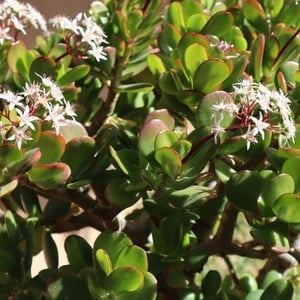
Jade
Another popular household succulent, Jade is only mildly toxic to dogs. If ingested, the symptoms are typically gastrointestinal related.
Signs of Jade Toxicity in Dogs
Vomiting, lethargy, and decreased appetite will usually resolve without any treatment. You may also see your dog experience an uncoordinated gait (stumbling) which can be concerning when witnessed.
Onset of Symptoms
Signs may not be evident due to the mild toxicity, but if noticed, they may develop within 1–4 hours of ingestion.

Kalanchoe (Devil’s Backbone, Mother-of-Millions, and Chandelier plant)
This popular flowering succulent belongs to a group of plants that contain toxins called cardiac glycosides (heart toxins).
Cardiac glycosides (GC's) are organic compounds that can affect the electrical function of the heart, stomach, and intestines, as well as the nervous system.
However, although these plants contain cardiac glycosides, these specific CG’s (specifically bufadienolides) don’t typically affect the heart when ingested; they cause gastrointestinal symptoms instead.
Signs of Kalanchoe Toxicity in Dogs
The gastrointestinal system is affected, resulting in vomiting and diarrhea. Ingestion is less likely to cause heart arrhythmias.
Onset of Symptoms
Symptoms typically develop within 4–12 hours of ingestion.
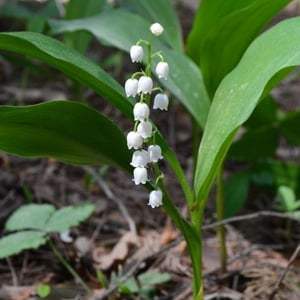
Lily of the Valley
Although the name ‘Lily of the valley’ may be confusing, this species of plant is different from the true lily species that cause serious and potentially fatal side effects IN CATS. True lilies are not toxic to dogs.
However, the lily of the valley plants are still very poisonous to dogs and if ingested by a pet, must be taken seriously and treated aggressively.
Signs of Lily of the Valley Toxicity in Dogs
Lily of the Valley contains cardiac glycosides like Kalanchoe (above) and symptoms can be severe and may include vomiting, nausea, diarrhea, decreased appetite, lethargy, a drop in heart rate, severe cardiac arrhythmias (abnormal heart rate and rhythm), weakness, and possibly seizures.
Onset of Symptoms
Symptoms often occur almost immediately due to their rapid absorption. However, symptoms can take up to 4–12 hours after ingestion, depending on the amount eaten.

Marijuana (THC – tetrahydrocannabinol, Cannabis, Pot, Mary Jane)
With recent and ongoing changes in the legalization of this product, its availability in both the medical and recreational markets has increased. Thus, increasing access and exposure to pets.
Cannabis sativa and cannabis indica are members of the Cannabaceae family. Their effects on people are, for the most part, well-known. However, ingestion by pets, these same effects result in toxicity.
Depending on the product ingested and whether it was combined with other products such as chocolate (as in a brownie) or highly concentrated (in an e-cigarette oil), the symptoms could vary from mild to severe.
Signs of Marijuana Toxicity in Dogs
Symptoms of toxicity may include an uncoordinated gait (ataxia), dilated pupils, drooling, vomiting, dribbling urine, as well as a slowed heart rate (bradycardia), tremors, and rarely seizures.
Onset of Symptoms
Signs are typically seen within several minutes of ingestion and may take up to 2 hours to develop depending on the product ingested.

Oleander (Rose Bay)
The attractive flowers and evergreen nature of this plant make this shrub popular in gardens everywhere. However, it's important to note that ALL parts of this plant are considered toxic to multiple species (e.g., dogs, cats, humans, horses, cattle, pigs, etc.).
It only takes a small amount of this plant to be ingested to cause toxicity. It has been reported that even consuming water that contained fallen leaves or handpicked flowers from this plant can cause toxicity.
The Nerium Oleander plant also contains cardiac glycosides specifically cardenolides, which interfere with the electrolyte balance of the heart as well as other muscles, resulting in cardiac and gastrointestinal issues.
Signs of Oleander Toxicity in Dogs
Symptoms of toxicity with these cardiac glycosides are typically associated with cardiovascular signs such as arrhythmias (e.g., abnormal heart rhythm and rate). Electrolyte abnormalities (e.g., a life-threatening high potassium level), gastrointestinal signs (e.g., nausea, drooling, vomiting, etc.), or central nervous system signs (e.g., tremors, seizures) have also been reported.
Onset of Symptoms
Symptoms typically develop within 4–12 hours of ingestion.
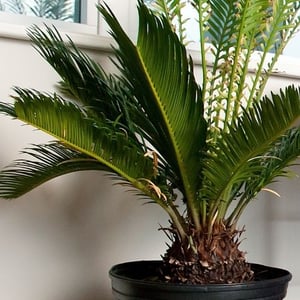
Sago Palm (Cardboard palm, Cycads, Coontie palm, Zamias)
Sago palms are not actually "palms," they are cycads, which are ancient seed plants that have a "crown"of large leaves and a stout trunk. However, because of their attractive tropical appearance, these plants are very commonly found inside homes, offices, and commonly used in landscaping. Homeowners, renters, and vacationers are rarely aware of how deadly they are to pets.
These plants are typically found in tropical and subtropical climates. The Bonsai version is a very popular ornamental form of the sago palm. ALL parts of sago palm plants are poisonous. However, it is the seeds (nuts) that are the most toxic part.
The sago palm contains a toxin known as cycasin, a carcinogenic and neurotoxic glycoside (compound) that when ingested, causes severe illness and can even be fatal.
Symptoms of Sago Toxicity in Dogs
Signs include vomiting, diarrhea, lethargy, lack of appetite, abnormal fluid accumulation in the abdomen, abdominal pain, jaundice (yellowing of the gums, eyes, skin), and black-tarry stool (melena). Aggressive treatment should be initiated ASAP. Even with aggressive treatment, the survival rate is approximately about 50%.
Onset of Symptoms
Ingestion results in severe liver failure in dogs. Acute gastrointestinal signs are usually seen first (e.g., drooling, decreased appetite, vomiting, diarrhea) and this is typically within 15 minutes to 3–4 hours after eating. Central nervous system signs can occur within hours to days post-ingestion (as a result of the neurotoxin and liver failure) including weakness, ataxia (wobbliness), tremors, or seizures may occur. Severe liver failure is usually diagnosed within 2–3 days post-ingestion.
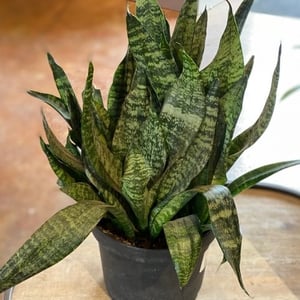
Snake Plant (Sansevieria, Mother-in-law’s Tongue)
Another popular houseplant species, due to its evergreen nature and stemless foliage that can stretch anywhere from 2' to 4' tall. Their leaves stick straight up, giving it its slang name ‘mother-in-law’s’ tongue. This plant is only mildly toxic if ingested by your dog, but it still warrants mentioning.
Signs of Snake Plant Toxicity in Dogs
Loss of appetite, vomiting, diarrhea, nausea, vomiting, drooling, swelling of the mouth, lips, or tongue, change in energy level.
Onset of Symptoms
Signs may take up to 4 hours to develop but could take as long as 8–12 hours.
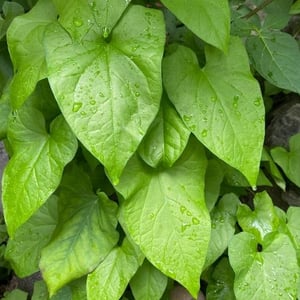
Sweetheart Ivy
This plant is an invasive species in North Carolina and can also be found in the Pacific Northwest. The heart-shaped leaves formed by these plants make them popular as indoor plants. Their vines enchantingly cascade down from their planter, so it makes this plant that much more accessible to your dog. If you do happen to have a sweetheart ivy plant, it is recommended you hang it up high.
The leaves of this plant are more toxic than the berries and also contain saponins as their toxic compound (hederagenin).
Signs of Sweetheart Ivy Toxicity in Dogs
Eating the leaves and its berries may result in excessive drooling, vomiting, abdominal discomfort, and diarrhea.
Onset of Symptoms
Signs may be seen within 4–8 hours of ingestion but may take up to 12 hours post-ingestion to develop.

Tulips and Hyacinths
Both hyacinths and tulips belong to the Liliaceae family and contain allergenic lactones or similar alkaloids. The toxins are found mainly within the bulb of the plants and when ingested, can result in severe clinical signs.
Poisonings are usually seen when a dog digs up bulbs that have recently been planted.
Signs of Tulip and Hyacinth Toxicity in Dogs
Similar to daffodils, when tulip or hyacinth bulbs are chewed on or ingested, it can result in irritation to the tissues of the mouth and throat, as well as excessive drooling, vomiting, nausea, and diarrhea.
When large amounts of this plant are consumed the more severe the symptoms are likely to be, changes in respiration rate and effort (difficulty breathing), and changes in heart rate (fast heart rate).
Onset of Symptoms
If a dog ingests the bulb of these plants, irritation of the mouth and gastrointestinal symptoms may occur almost immediately. In large amounts, heart and respiratory changes can be seen within 2–4 hours.

Myth Buster: Are Poinsettias Toxic for Pets?
Ironically, poinsettias, one of the more well-known holiday plant hazards for pets, may not be as hazardous to pets as once thought. This is due to the low level of toxicity and mild symptoms they cause if ingested. Medical intervention is rarely needed unless symptoms become severe or persistent.
Signs of Poinsettia Toxicity in Dogs
Symptoms may include vomiting, drooling, and, rarely, diarrhea. Their milky sap can irritate the skin, causing redness, swelling, and itchiness. Repeated exposure of the sap to the skin can result in more intense dermal irritation.
Onset of Symptoms
Signs may be missed due to their mild nature; however, they may become apparent within 2–4 hours of ingestion or with repeated exposure.
Signs Your Dog May Have Eaten a Toxic Plant
The degree of toxicity and the symptoms you may notice depend on the specific plant and the amount ingested, as well as the part(s) of the plant your dog may have consumed.
Your dog’s body weight, any existing medical conditions, medications they are taking, as well as a host of other factors may also affect the severity and the outcome.
It is important that you contact your veterinarian, veterinary emergency service, or an animal-specific poison control hotline immediately if you believe your dog has nibbled on or eaten any amount of a toxic plant or flower.
If you can specifically identify the plant – take a photo or bring the plant with you – so that the veterinarian can determine the best form of treatment for your dog.
Symptoms of toxic plant poisoning in dogs may include:
- Mental dullness, decreased interaction, or hiding
- Severe irritation or ulceration of the mouth, lips, and tongue: Signs include a dog pawing at their mouth, decreased appetite, gagging, drooling, or bad breath
- Difficulty swallowing
- Vomiting
- Stomach pain: Signs that your dog has stomach pain might include decreased appetite, low energy, hiding, vomiting, and a decrease in urination and bowel movements
- Diarrhea
- Excessive drooling
- Changes in urine: This could be a change in color or change in the amount of urine (could be more or less)
- Changes in thirst (could be increased or decreased)
- Low energy
- Loss of appetite
- Coma
The full list of toxic plants is extensive for both indoor and outdoor plants. You can get the full list from the ASPCA's Animal Poison Control page of toxic and non-toxic plants. Hopefully, this article has helped inform you as you go to the nursery to choose your greenery.



